MARIANI’S
Virtual
Gourmet
AUGUST 11,
2019
NEWSLETTER

❖❖❖
IN THIS ISSUE
STAYING AND EATING
AROUND ZÜRICH
By John Mariani
NEW YORK CORNER
RUSSIAN SAMOVAR
By John Mariani
NOTES FROM T
THE WINE CELLAR
HOW TO MAKE WINE TASTES BETTER
WITH A LITTLER SALT, PEPPER AND FAT
By John Mariani
❖❖❖
STAYING AND EATING
AROUND ZÜRICH
By John Mariani
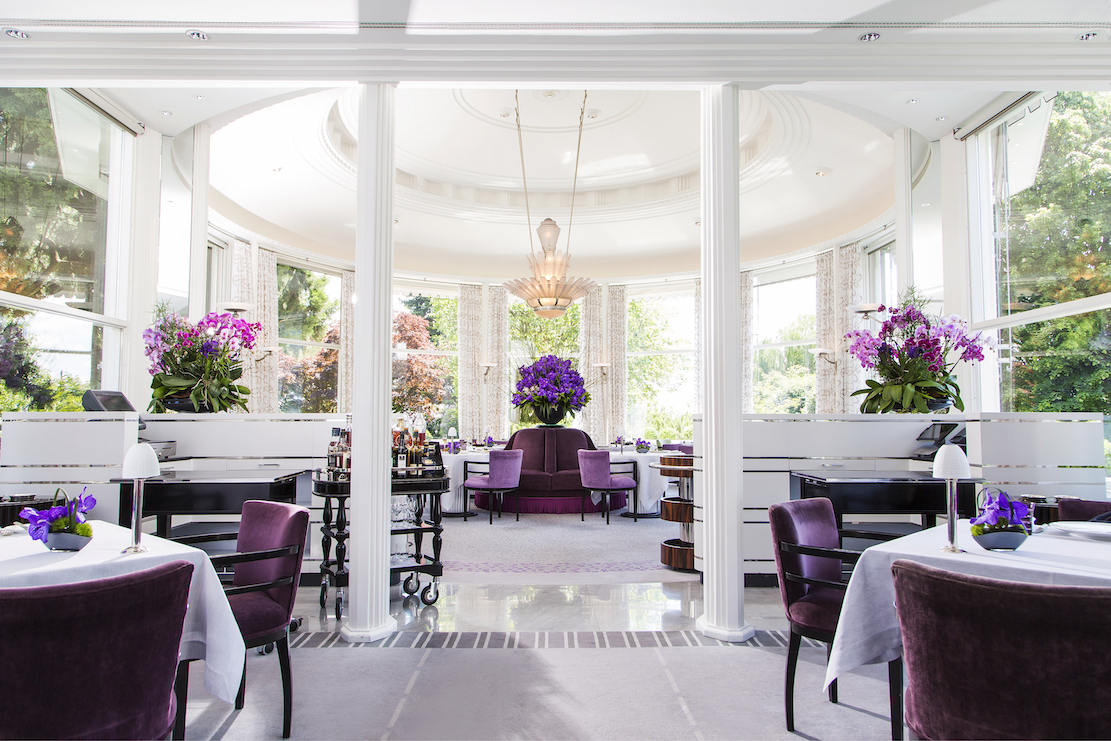
Pavillon Restaurant at Hotel Baur au Lac
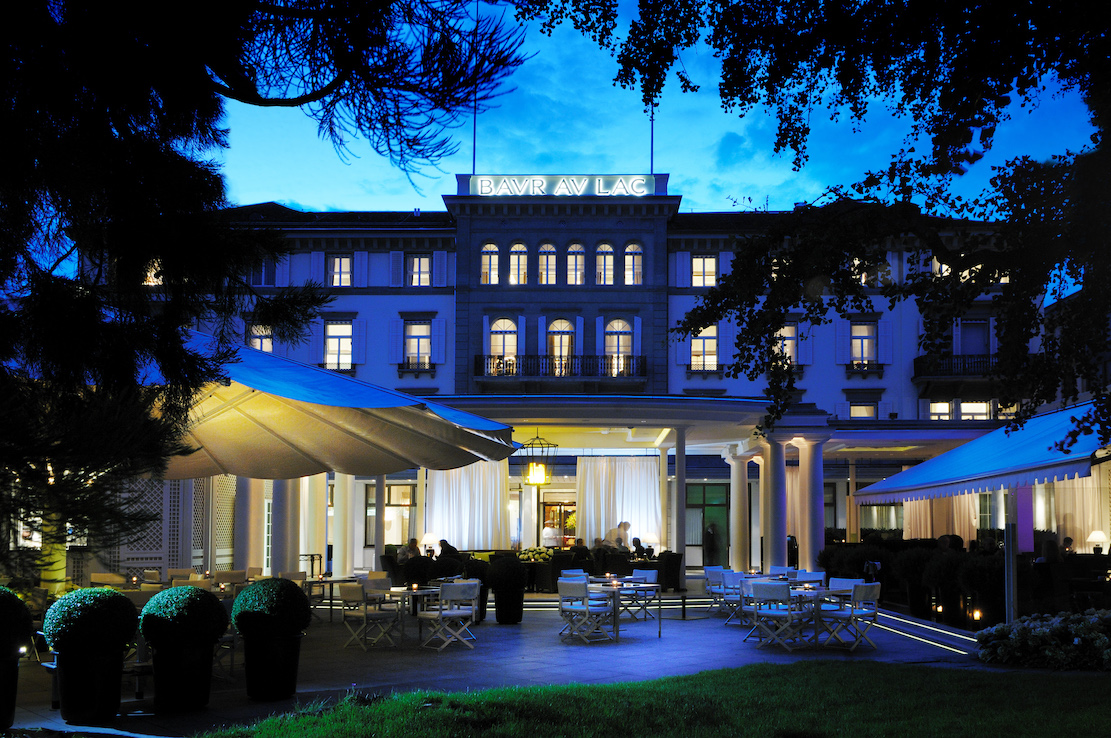 As an
established classic, the Baur au Lac
hotel, opened in 1844, has
hosted everyone from Sophia
Loren and Brigitte Bardot to Marc Chagall and
Alfred Hitchcock. In this century
it has kept pace with contemporary ideals of
comfort and cuisine through a $50
million renovation that reconfigured 32 rooms and
suites into 22 larger ones
with luxurious new marble bathrooms, Bose sound
systems, 25 English channels on
TV, dependable WiFi and a magnificent new rooftop
patio overlooking the city.
The entry hall and hall lounge have been
completely refurbished, now with a
glorious raised glass dome ceiling.
Yet, somehow, everything seems the same in
so many cherished ways.
As an
established classic, the Baur au Lac
hotel, opened in 1844, has
hosted everyone from Sophia
Loren and Brigitte Bardot to Marc Chagall and
Alfred Hitchcock. In this century
it has kept pace with contemporary ideals of
comfort and cuisine through a $50
million renovation that reconfigured 32 rooms and
suites into 22 larger ones
with luxurious new marble bathrooms, Bose sound
systems, 25 English channels on
TV, dependable WiFi and a magnificent new rooftop
patio overlooking the city.
The entry hall and hall lounge have been
completely refurbished, now with a
glorious raised glass dome ceiling.
Yet, somehow, everything seems the same in
so many cherished ways.
Over two visits in five years I’ve seen the evolution
 first hand while enjoying
the same warm
congeniality of a staff whose members speak several
languages and lack any of
the pretensions I too easily find in so many
five-star hotels. If relaxing is
at least as important for business travelers as it
is for romantics, then the
Baur au Lac, located on the quieter left side of the
River Linmat and less than
ten minutes from the Bahnhof train station, is ideal
for both.
first hand while enjoying
the same warm
congeniality of a staff whose members speak several
languages and lack any of
the pretensions I too easily find in so many
five-star hotels. If relaxing is
at least as important for business travelers as it
is for romantics, then the
Baur au Lac, located on the quieter left side of the
River Linmat and less than
ten minutes from the Bahnhof train station, is ideal
for both.
There are three restaurants—La Terrasse, which has become one of the city’s most popular cocktail settings, with a light menu; the casual Baur (not yet open when I visited); and the graceful Pavillon, done in flora pastels and rich colors of violet, with a welcoming arcade and a panorama of the gardens. Acoustics are perfect for conversation, despite an unintended “whispering gallery” effect that allows some corners to hear conversations from across the room, which, I’m told, is why lawyers won’t sit at those particular tables.
This year Pavillon earned its second Michelin star for chef Laurent Eperon’s cuisine, while its enthusiastic sommelier, Marc Almert, who looks too young even to drink wine, was awarded the Association de la Sommelerie Internationale’s “Best Sommelier in the World 2019,” overseeing a 38-page wine list, with an admirable focus on Swiss labels under 100CHF.
 There’s a two-course lunch
at 76CHF, as well as à la carte, and at dinner both
an à la carte and a
“Harmonie” menu of nine courses (205CHF, with wine
pairings at 95CHF and
110CHF)—prices that, while expensive,
There’s a two-course lunch
at 76CHF, as well as à la carte, and at dinner both
an à la carte and a
“Harmonie” menu of nine courses (205CHF, with wine
pairings at 95CHF and
110CHF)—prices that, while expensive,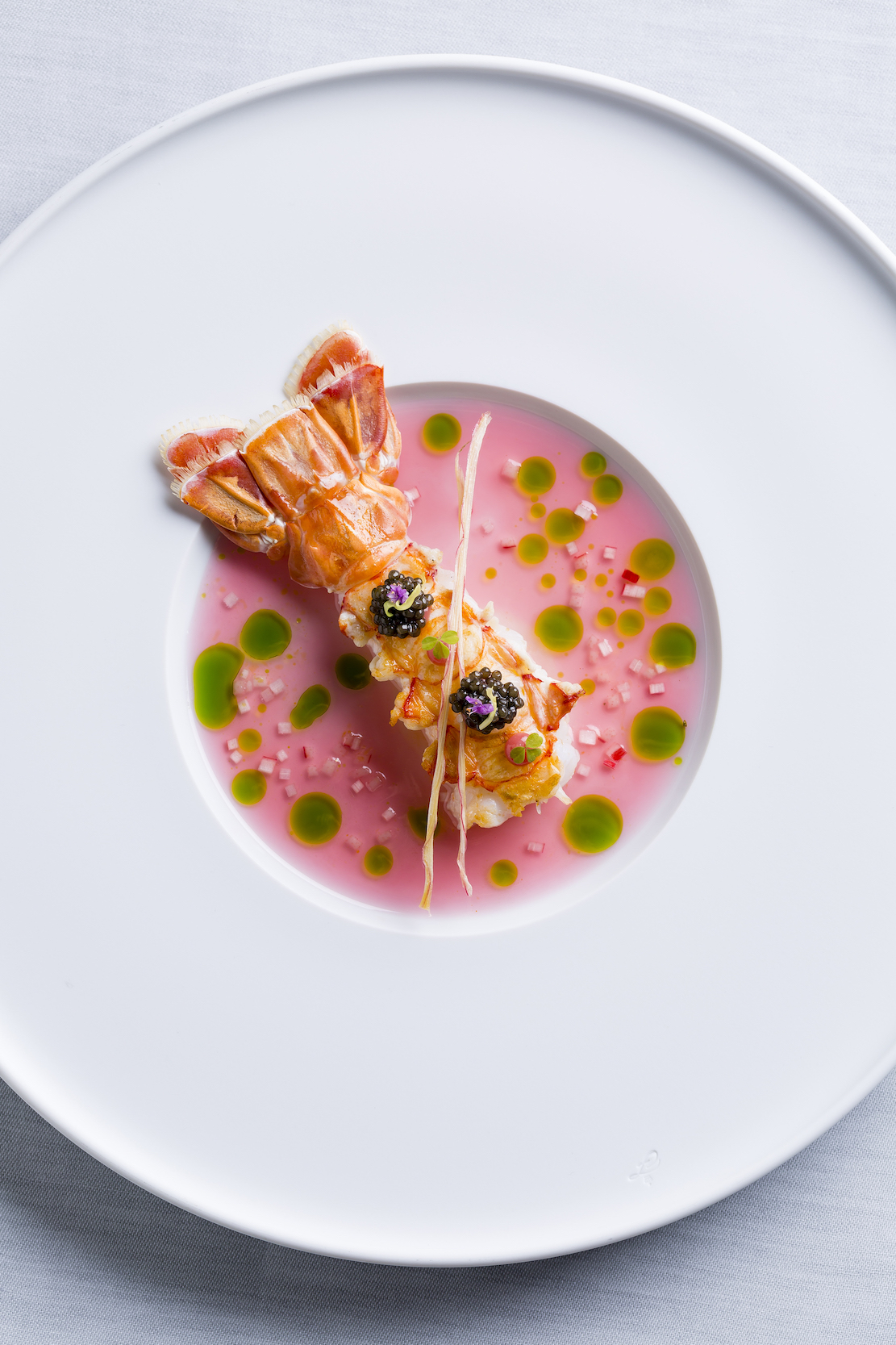 are
considerably below what you’d find at
two-star hotel restaurants in Paris, like Le Meurice
Alain Ducasse and Le
Gabriel at La Réserve.
are
considerably below what you’d find at
two-star hotel restaurants in Paris, like Le Meurice
Alain Ducasse and Le
Gabriel at La Réserve.
My wife and I asked for two different three-course menus, each exquisitely presented. There were, of course, complimentary amuses like gougères puffs with caviar and vegetables in a dashi broth. We went on to King crab lightly flavored with red curry, and a scallop graced with an emulsified olive-lemon sauce. Next came a delicately thin raviolo stuffed with wild turbot and osietra caviar.
One main course was really several combined: Rabbit meat in a ballotine; the loin roasted with fragrant rosemary; its liver within cannelloni; the leg meat in a parslied yogurt. Veal came “Metternich style,” with morels, foie gras and a bouquet of celery puree, with carrot gelée. Our desserts were hazelnut truffles brought dramatically in a smoking glass cloche, and juicy pomelo with a light meringue.
The meal showed how cannily Eperon marries tradition with his own modern creativity in every dish. And Almert’s accompanying wine choices were spot on throughout.
 Very
different in style and
every bit as modern as any hotel in Europe, the Park Hyatt focuses on a contemporary
approach based on efficient
and congenial service by a young lobby staff imbued
with a mission to go beyond
all the requisite answers to business and tourist
queries along with personal
insight into what is going on in Zürich, from the
new restaurants to the arts
and entertainments.
Very
different in style and
every bit as modern as any hotel in Europe, the Park Hyatt focuses on a contemporary
approach based on efficient
and congenial service by a young lobby staff imbued
with a mission to go beyond
all the requisite answers to business and tourist
queries along with personal
insight into what is going on in Zürich, from the
new restaurants to the arts
and entertainments.
The hotel is only 12 years old, with just 138 rooms. (Oddly enough, Zürich has no Ritz-Carlton, Mandarin Oriental or Four Seasons hotels, so the Park Hyatt is ideal for those expecting that level of five-star luxury and service.) Largely encased in glass,
 the very
spacious rooms, not least
the 1,722-square-foot Presidential Suite on the top
floor, get plenty of light
and have both a large marble tub and separate
showers. Zürich is a quiet city,
and the rooms at the Park Hyatt are quieter still.
the very
spacious rooms, not least
the 1,722-square-foot Presidential Suite on the top
floor, get plenty of light
and have both a large marble tub and separate
showers. Zürich is a quiet city,
and the rooms at the Park Hyatt are quieter still.
There are two restaurants. The Onyx Bar and Lounge, set just off the lobby, are casual, chic and comfortable spaces set with sofas and club chairs, with high ceilings, fanciful modern artwork and a soothing fireplace. The menu is on the light side but the cooking is substantial. My wife and I enjoyed dishes like risotto with white garlic and poached egg (17CHF); fragile pastry tuiles stuffed with
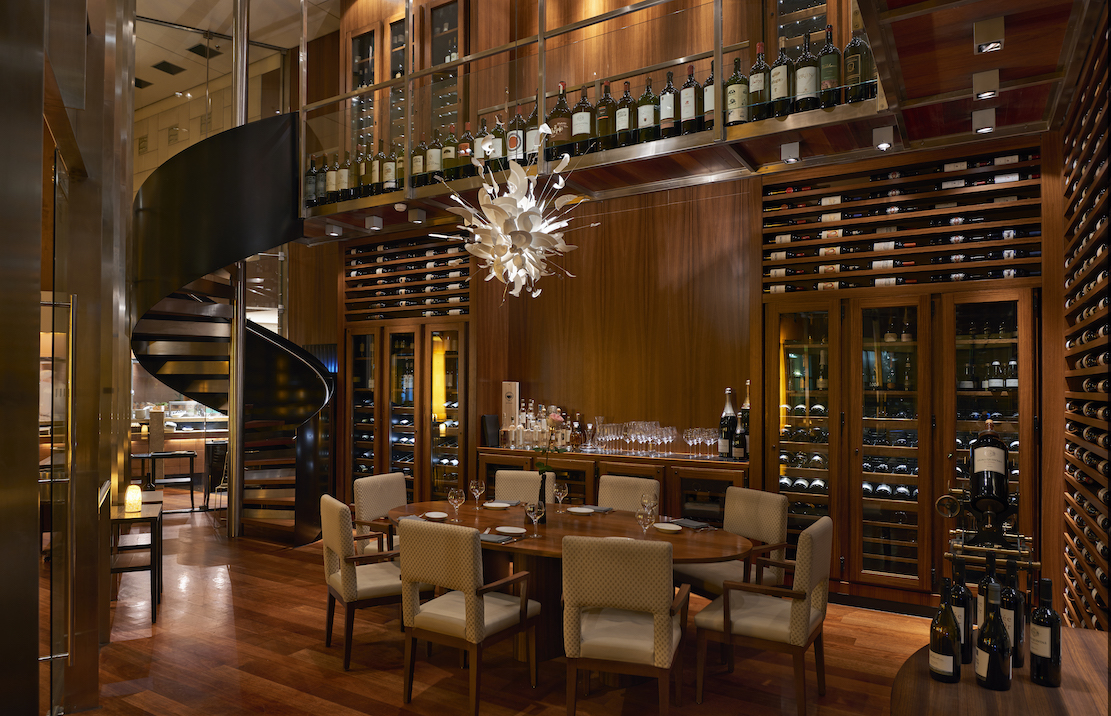 a luscious
cheese mousse (25CHF); lake pike perch with fregola
in a subtle reduction (38CHF); and a burger made
with Alpine chicken and an egg
and French fries (38CHF). Two desserts—crème brûlée
(13CHF) and a melting
chocolate fondant (14CHF)—were excellent, as you
expect in Switzerland.
a luscious
cheese mousse (25CHF); lake pike perch with fregola
in a subtle reduction (38CHF); and a burger made
with Alpine chicken and an egg
and French fries (38CHF). Two desserts—crème brûlée
(13CHF) and a melting
chocolate fondant (14CHF)—were excellent, as you
expect in Switzerland.
The slightly more upscale dining option (for breakfast, lunch and dinner) is the parkhuus (left), a vast paneled room with soaring ceilings, glass walls and candles on the tables. You pass an open kitchen with wood-burning oven as you enter, where chef Frank Widmer produces a sophisticated, modern cuisine based on Swiss ingredients. The wine list is superbly selected.
We enjoyed a lavish dinner beginning with an amuse
Families and children are welcome; they even offer special children’s china bowls as well as little books to occupy their time.
(This winter the Park Hyatt Zürich is offering a winter package that includes two days in Zürich with transfers to the Grand Bellevue Gstaad for four nights, starting at CHF5100)
Raclette is made from cheese of the same name, which is matured between three and six months, and this eatery offers variants (15CHF to 19.90CHF,
 or all-you-can eat at
49.90CHF) of regional cheeses like
blue Blaue Schalk
from Schalchen, truffled
from Käserei and goat’s cheese from Girenbad.
In addition there are to
some wonderful, smoky tarte
flambées
(21.90CHF to 22.90CHF) decadently topped with
crème fraîche, bacon and other
ingredients (right).
or all-you-can eat at
49.90CHF) of regional cheeses like
blue Blaue Schalk
from Schalchen, truffled
from Käserei and goat’s cheese from Girenbad.
In addition there are to
some wonderful, smoky tarte
flambées
(21.90CHF to 22.90CHF) decadently topped with
crème fraîche, bacon and other
ingredients (right).
One of the most popular Italian restaurants in Zürich is Santa Lucia, part of a Swiss chain, located on the corner of Waagstrasse and what is rightly called Paradeplatz, affording a broad view of the passersby. Inside is a pleasant two-level dining room with a fleet-footed staff in constant motion, taking orders, pouring wine and delivering delicious pizzas (18CHF to 22CHF) and well-wrought pastas like spaghetti all’arrabiata with red peppers (19CHF) and risotto with wild mushroom (24CHF).
Remember: Prices quoted include tax (3.7% for hotels, 2.9% for restaurants) and service charge. The Swiss franc is about on par with the U.S. dollar.
❖❖❖
By John Mariani
256 West 52nd Street
212-757-0168
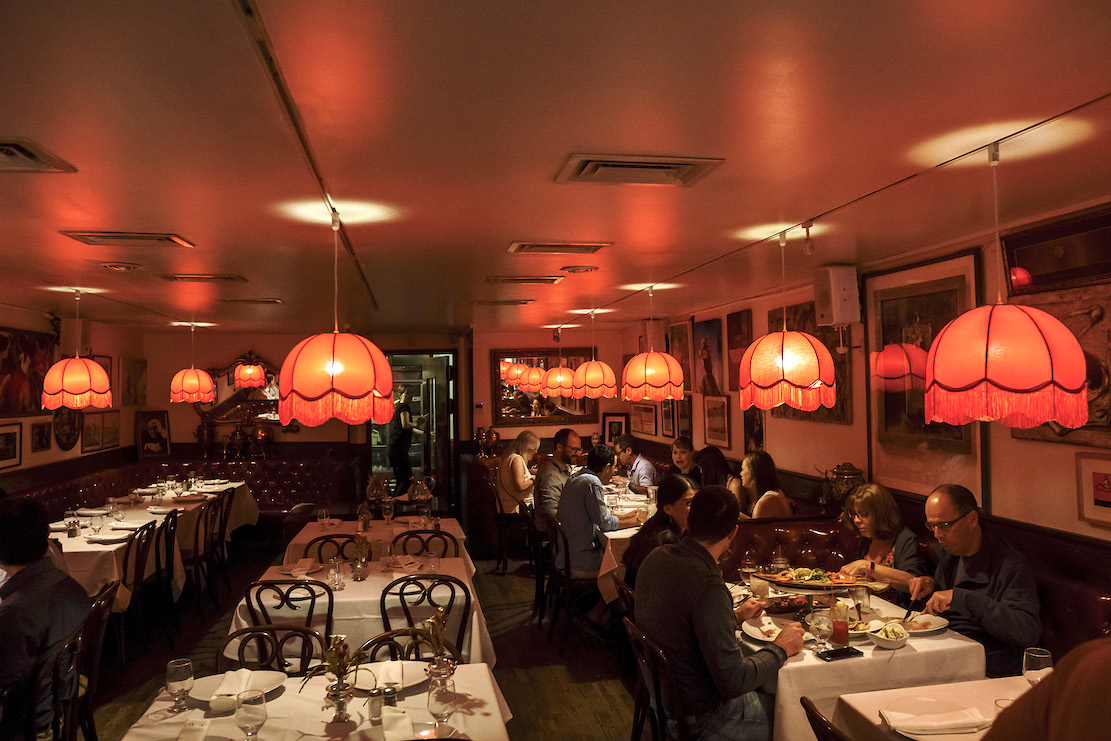
Photo by Stefano Giovannini
Outside
of Brooklyn’s gargantuan Russian banquet
halls—where the flow of vodka makes up for the
taste of the food—Russian restaurants in New
York are few and far between. In Manhattan,
along with the Russian Tea Room, which opened in
1927, Russian Samovar is one of the keepers of a
Russian culinary flame, serving both the cuisine
of the Tzarist aristocracy—with plenty of smoked
salmon and caviar—along with dishes enjoyed by
Russia’s common people, like pelmeni
dumplings in broth and both cold and hot
borscht.
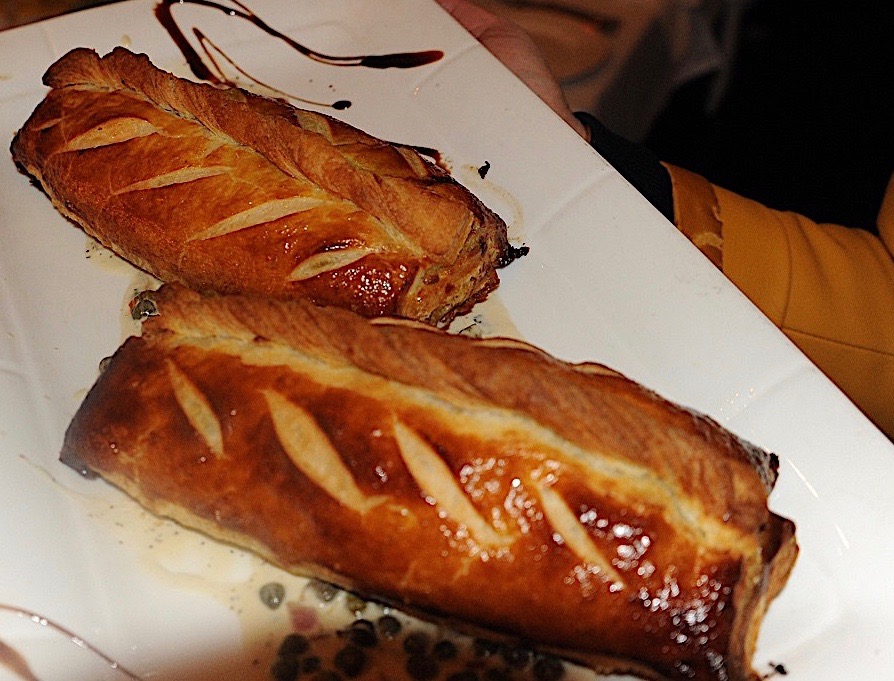 Russian
Samovar dates to 1986, when Roman Kaplan, ballet
master Mikhail
Baryshnikov and Nobel laureate
poet Joseph Brodsky invested in a Theater
District space that was once an old Sinatra
hang-out. Brodsky’s favorite table is still
preserved there, and Baryshnikov's baby grand
piano is still used by nightly performers. A
romantic scene with Baryshnikov and Sarah Jessica
Parker in “Sex and the City” was filmed there.
Russian
Samovar dates to 1986, when Roman Kaplan, ballet
master Mikhail
Baryshnikov and Nobel laureate
poet Joseph Brodsky invested in a Theater
District space that was once an old Sinatra
hang-out. Brodsky’s favorite table is still
preserved there, and Baryshnikov's baby grand
piano is still used by nightly performers. A
romantic scene with Baryshnikov and Sarah Jessica
Parker in “Sex and the City” was filmed there.
Today Kaplan’s daughter Vlada
runs Russian Samovar with the spirit in which it
was conceived, and the décor reflects a kind of
sentimental nostalgia you feel in the rosy glow
cast by fringed lampshades and the photos and
artwork that line the walls. Of course, the
visiting musicians indulge guests with all the
familiar Russian songs, from “Dark Eyes” to “Those
Were the Days, My Friend,” intermingled with some
Cole Porter and Billy Joel.
Photo
by Nadja Sayej
With
my wife and brother-in-law, both with Russian
blood and both fluent in the language, we ate from
all over the menu and found it convincingly
authentic from the pickled herring ($16) to the
beef stroganoff ($29) to a sour cream cake called
le
smetannik ($13). Portions are generous. The
menu is amazingly long, the wine list absurdly
short and the service staff, on two visits, seemed
immune to guests trying to get their attention.
Your table might wish to
splurge with a lavish Imperial fish platter ($150)
piled high with black and red caviar, smoked
butterfish, 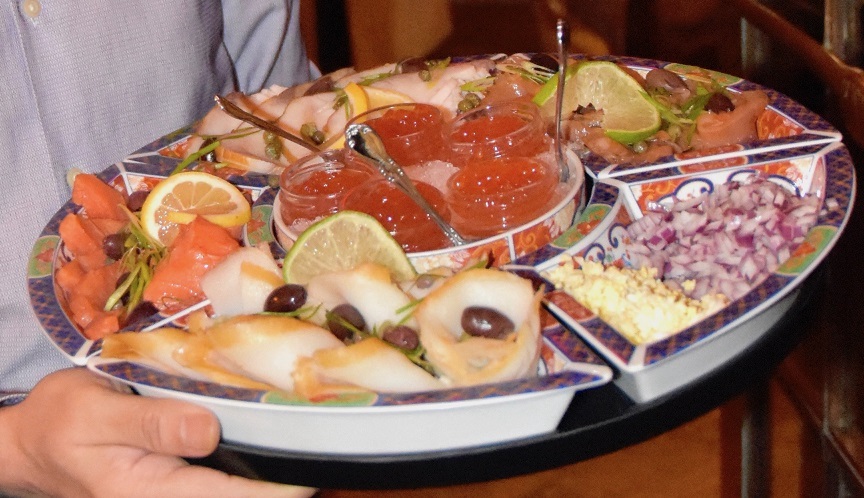 smoked
salmon, two varieties of herring and thin blini.
The lovely rose-red borscht ($13) is based on a
family recipe that goes back seven decades, and
right now there is a cold summer version ($12).
Eggplant “caviar” ($15) is a sweet and sour puree
of eggplant, tomato and peppers.
smoked
salmon, two varieties of herring and thin blini.
The lovely rose-red borscht ($13) is based on a
family recipe that goes back seven decades, and
right now there is a cold summer version ($12).
Eggplant “caviar” ($15) is a sweet and sour puree
of eggplant, tomato and peppers.
A complement to the fish
platter is a meat platter ($30) with a veal
roulade, excellent beef tongue, smoked meats and
the dried, cured beef called basturma.
Satsivi ($18) is a Georgian specialty of
chicken cut into a dice and aggrandized with a
wonderful coriander-and-walnut
sauce.
Photo by
Lisa Zari
One
of the cherished comfort foods of Russian home
cooking is pelmeni,
light veal and pork dumplings in a rich chicken
broth with sour cream ($14), or the alternative pelmeni
stroganoff with a topping of beef stroganoff
($23), which is as 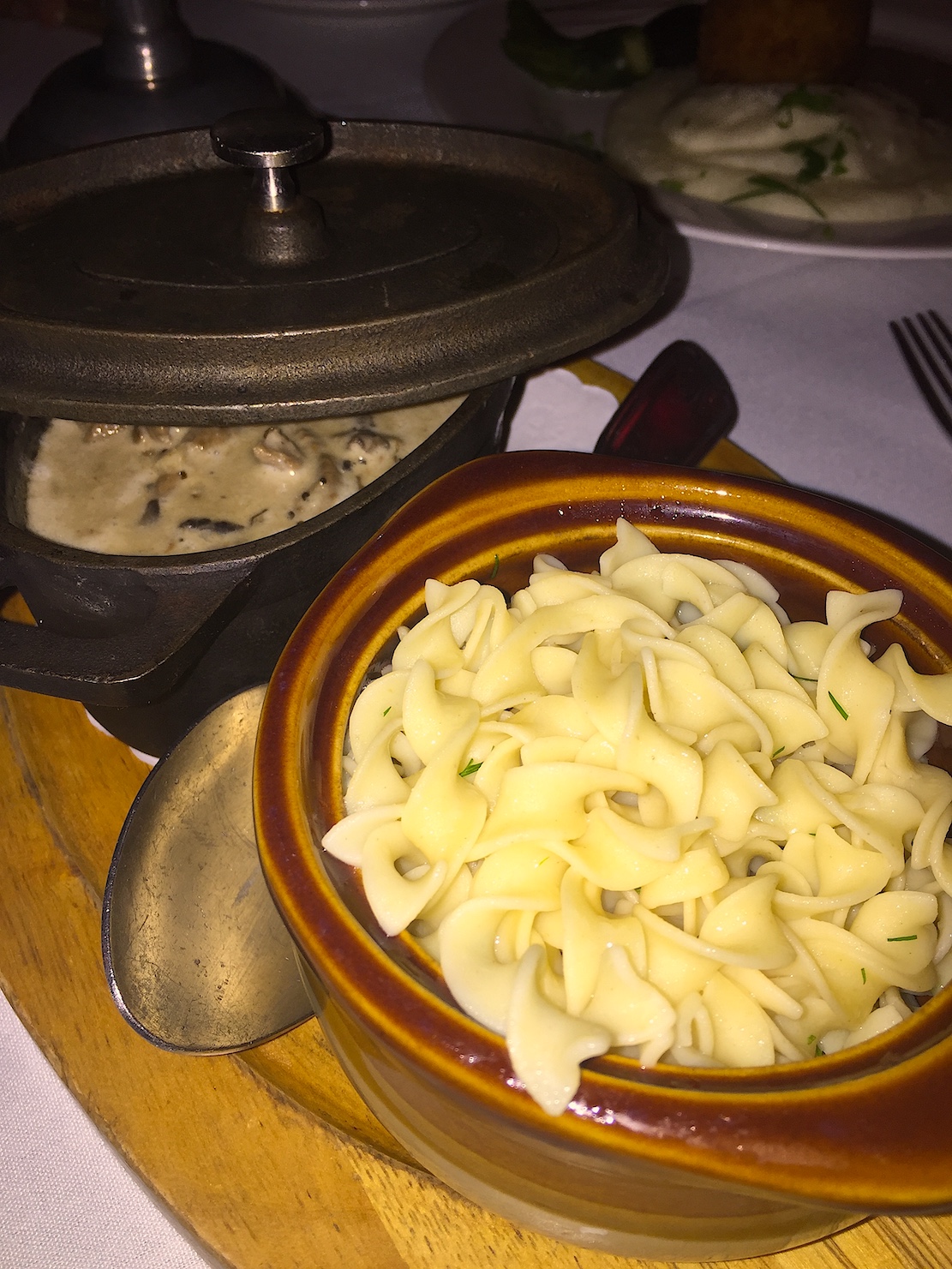 much a
hearty main course as it is an appetizer. Similar
dumplings, filled with a choice of potato, onion,
mushroom or cherry, called vareniki
($15) are pan-fried with sour cream—the cherries
are something special. Khachpuri
($15) is a flakey three-cheese pastry of a kind
found throughout Eastern Europe.
much a
hearty main course as it is an appetizer. Similar
dumplings, filled with a choice of potato, onion,
mushroom or cherry, called vareniki
($15) are pan-fried with sour cream—the cherries
are something special. Khachpuri
($15) is a flakey three-cheese pastry of a kind
found throughout Eastern Europe.
The seafood is of good quality,
though I prefer the Russian meat dishes, including
that hearty beef stroganoff (left; Photo:
Galina Stepanoff-Dargery) in
its rich, creamy mushroom sauce, accompanied by
buttered egg noodles, mashed potatoes or kasha
($29). Succulent, long-braised lamb country style
($33) is a fine alternative for a hefty main
course. Oddly enough, the only dish that
disappointed me was the chicken Kiev ($29; Photo by Nadja Sayej), whose
seasoned butter under the skin is supposed to gush
out after being cooked and the chicken sliced open
(right) .
Here the chicken itself was bland and overcooked,
not helped  by the
mere dribble of butter that emerged.
by the
mere dribble of butter that emerged.
For dessert, I liked that sour cream le smetannik
cake, and there’s also a good honey cake called medovik
($14).
For a true Russian closing, have the Russia tea ($7), which is served with cherry preserves and lemon on the side. By tradition, sipped in a small glass with a spoon in it with which to eat the preserves, it is an ending that makes Russians pine for a time when, as the words of “Those Were the Days, My Friend” go, “Oh my friend we're older but no wiser/For in our hearts the dreams are still the same.”
❖❖❖
BY ADDING SALT, PEPPER AND FAT
BY John Mariani
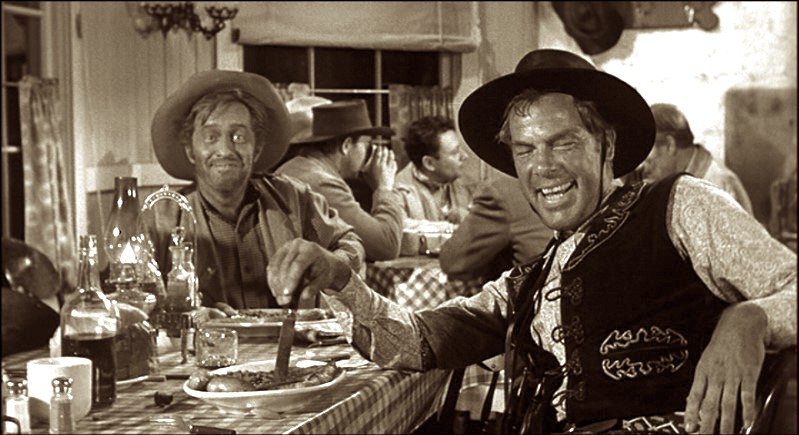
It was an epiphany,
though not the first of its
kind, when I happened to taste a grain or
two of coarse salt 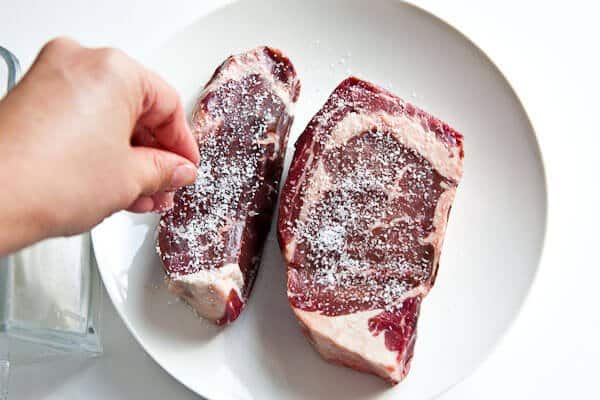 on
some softshell
crabs before I had a sip of Vermentino,
which, tasted on its own, would have
been a pleasant example of its kind. But
those two grains of coarse salt
sparked my palate and increased the
flow of juices so that when the wine
washed in over my tongue, it seemed to
burst with flavor, definitely enhancing
the wine and, of course, the meaty
softshell crabs.
on
some softshell
crabs before I had a sip of Vermentino,
which, tasted on its own, would have
been a pleasant example of its kind. But
those two grains of coarse salt
sparked my palate and increased the
flow of juices so that when the wine
washed in over my tongue, it seemed to
burst with flavor, definitely enhancing
the wine and, of course, the meaty
softshell crabs.
There’s an old saying that
salt makes its
presence felt only in its absence, which is
not to say, the more salt the
better. Of recent discovery is how a pinch of
salt in caramel or chocolate
boosts flavor immensely, so that it’s almost
become ubiquitous in such
confections.
The same thing happened
years ago when I served
my younger son a thick ribeye that I’d
seasoned with coarse salt then charred on
a charcoal grill to a beautiful crust while
retaining its medium-rare redness
within. He took a sip of a big California
Cabernet, put down his fork and
exclaimed, “Dad, this steak is fantastic!
What did you do to it?” It was a
very
good piece of beef, to be sure, but the
addition of that rock salt before cooking
and a dash afterwards had a vivid effect on
its bloody minerality and sweet fat
that really was worthy of my son’s
exclamation.
Black pepper, though a more
pungent palate
piercer, has much the same effect, though more
so with red wines, which is why
the French classic steak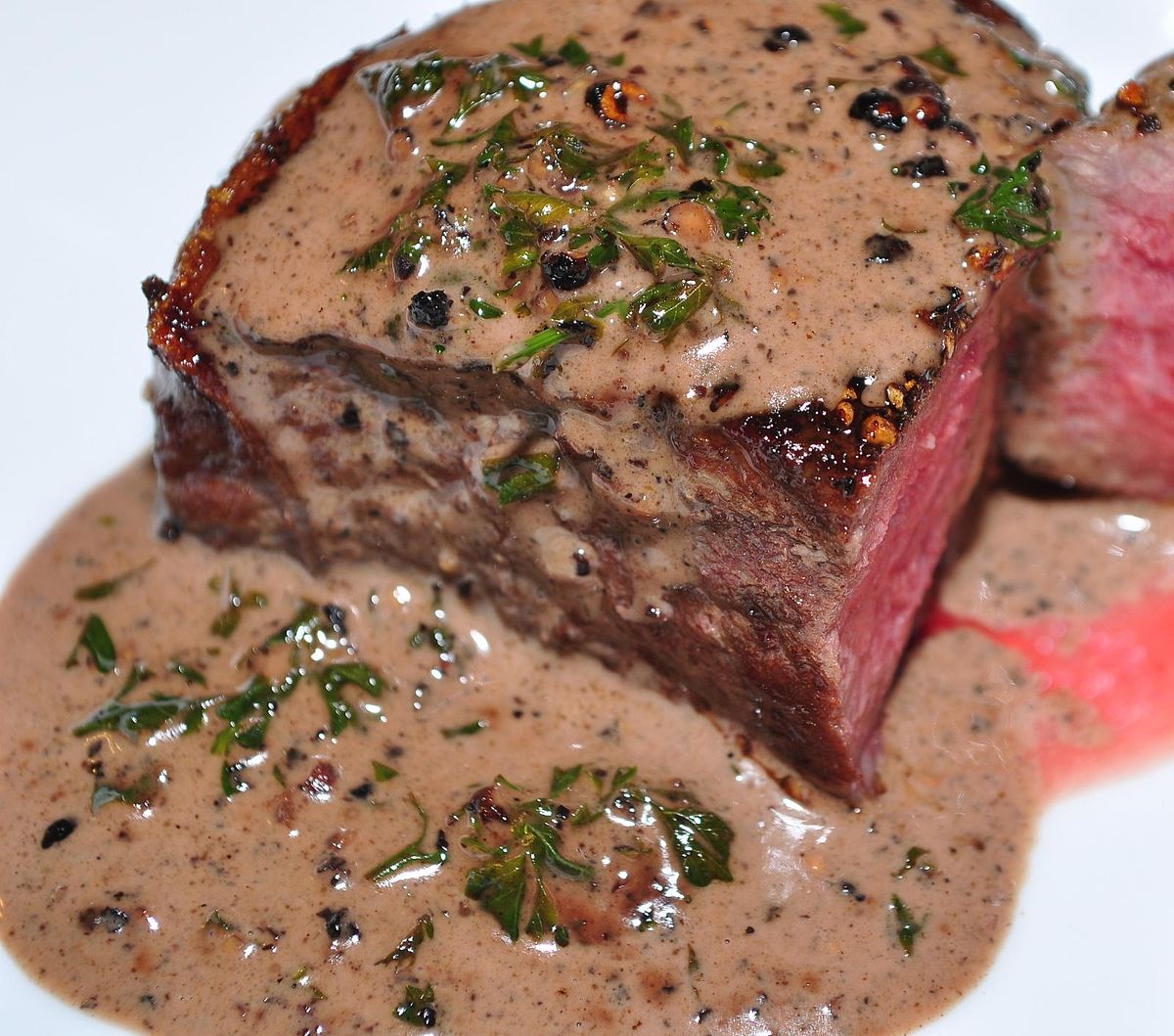 au poivre,
with a lot of coarsely ground pepper in a
cream sauce (right),
is such a powerful
carrier of flavor with a sturdy red wine like
Cahors. The same goes for the
Roman pasta dish cacio e
pepe, in
which the pasta is coated (not really sauced)
with coarsely ground pecorino
cheese and black pepper, which gives a
tremendous boost to both a modest red
Italian wine like Valpolicella or Bardolino,
as well as enriching the
complexity of a Southern Italian red like
Taurasi or Nero d’Avola. The
salt and fat of the cheese and the
punch of the black pepper marry in an
elemental way.
au poivre,
with a lot of coarsely ground pepper in a
cream sauce (right),
is such a powerful
carrier of flavor with a sturdy red wine like
Cahors. The same goes for the
Roman pasta dish cacio e
pepe, in
which the pasta is coated (not really sauced)
with coarsely ground pecorino
cheese and black pepper, which gives a
tremendous boost to both a modest red
Italian wine like Valpolicella or Bardolino,
as well as enriching the
complexity of a Southern Italian red like
Taurasi or Nero d’Avola. The
salt and fat of the cheese and the
punch of the black pepper marry in an
elemental way.
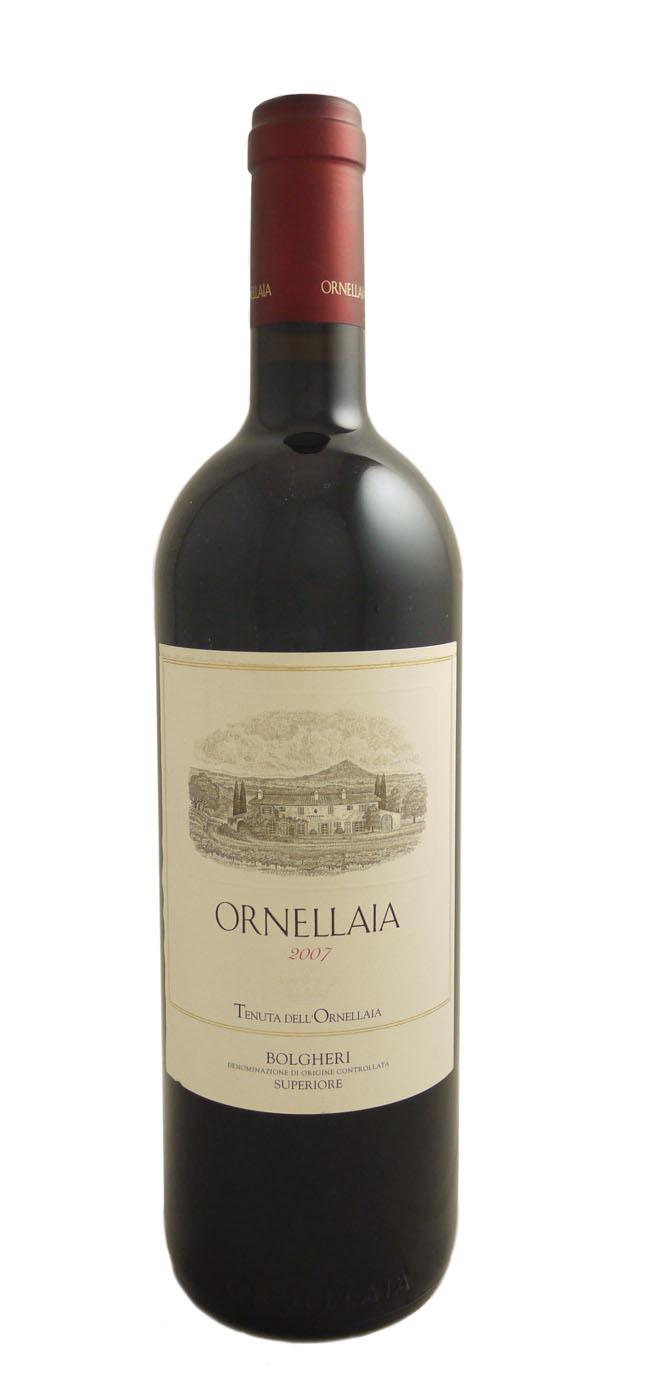 Which
brings me to the subject of fat and wine
drinking. Some years ago I was giving a
tasting of expensive Tuscan red wines
like Ornellaia (left) and Sassicaia, at a
wine exposition in Florida to be held at one
o’clock. I had driven three
hours from another city, without benefit of
breakfast, and was ravenous when I
got to my hotel, just minutes from the expo. I
immediately ordered a rare
hamburger and French fries, and when they
arrived, I wolfed them down and
dashed to the tent where I was leading the
tasting.
Which
brings me to the subject of fat and wine
drinking. Some years ago I was giving a
tasting of expensive Tuscan red wines
like Ornellaia (left) and Sassicaia, at a
wine exposition in Florida to be held at one
o’clock. I had driven three
hours from another city, without benefit of
breakfast, and was ravenous when I
got to my hotel, just minutes from the expo. I
immediately ordered a rare
hamburger and French fries, and when they
arrived, I wolfed them down and
dashed to the tent where I was leading the
tasting.
The flavors of my quick
lunch were still on my
palate, not least the fat of the beef and the
oil of the fries, in addition to
the salt and pepper I added. And when I began
tasting those wines, all of which
I knew well from drinking them over many
years, the flavors exploded in my
mouth—a reaction I told my audience about. It
was as if I’d never really tasted
these wines before! The simple gustatory fact
is, fat carries flavors,
especially those of wine grapes.
As everyone knows, the sense of
smell is the
one that allows one to appreciate myriad
sweet, salty, sour and bitter flavors,
and fat and pepper have their own olfactory
stimulants. So the combinations
build upon one another.
And what about red peppers
in various forms,
whole, dried or powdered? I certainly consume
them 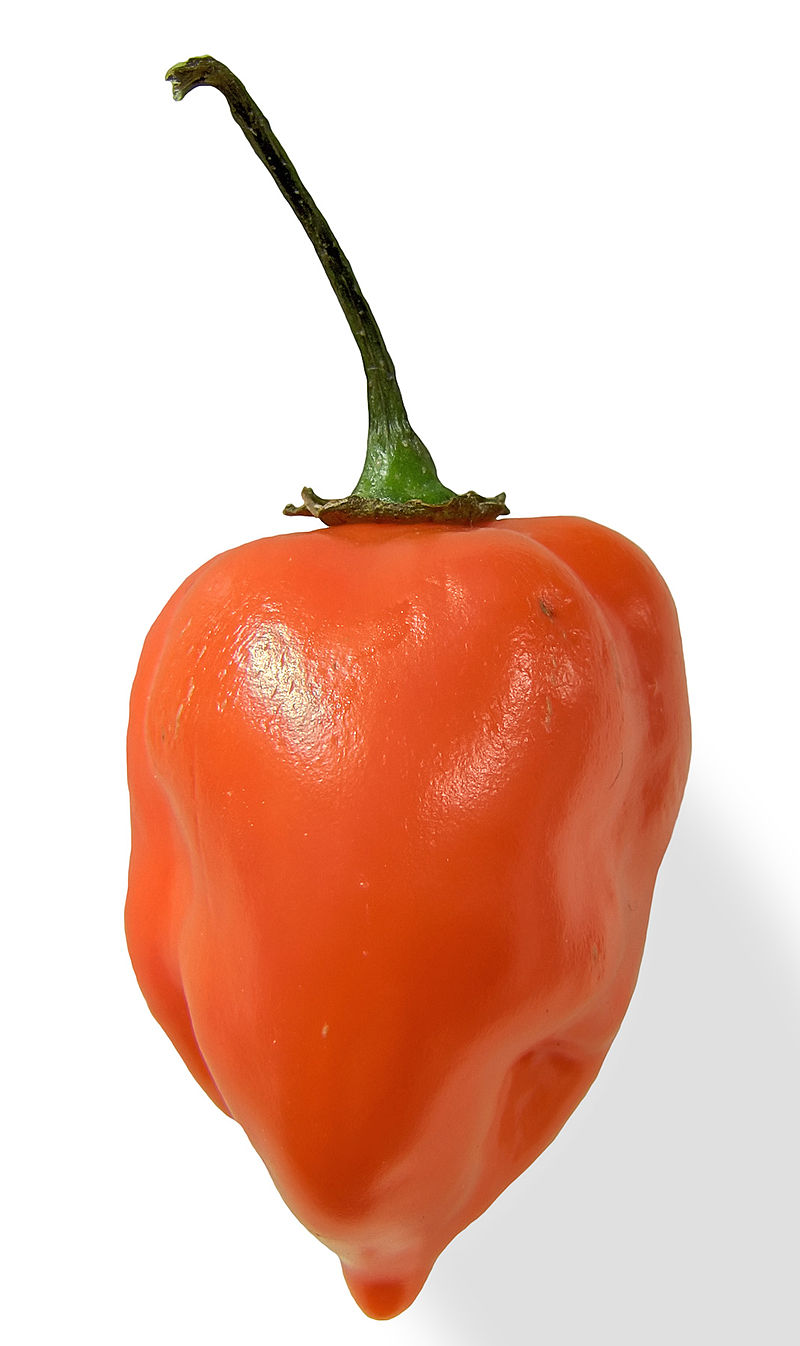 all
the time with all sorts
of cuisines—Mexican and Asian, certainly—but I
always prefer beer. Reams have
been written about pairing wines with Indian vindaloo or Sichuan beef or
Yucatan chile, but the very
characteristic that makes such pepper
condiments so attractive—their heat—in
such dishes, along with distinct added spices
and seasonings as varied as
cumin, coriander, ginger, soy sauce, fish
sauce and hoisin are too strong to
marry well with any white wine, however
refreshing, while most red wines’
flavors are blasted into the background under
the assault of a habanero pepper.
Tabasco is not kind to wine. (Incidentally, I
swabbed a little very hot harissa
condiment on those softshells,
which not only ruined the wine but detracted
from any delicacy the crustaceans
had.)
all
the time with all sorts
of cuisines—Mexican and Asian, certainly—but I
always prefer beer. Reams have
been written about pairing wines with Indian vindaloo or Sichuan beef or
Yucatan chile, but the very
characteristic that makes such pepper
condiments so attractive—their heat—in
such dishes, along with distinct added spices
and seasonings as varied as
cumin, coriander, ginger, soy sauce, fish
sauce and hoisin are too strong to
marry well with any white wine, however
refreshing, while most red wines’
flavors are blasted into the background under
the assault of a habanero pepper.
Tabasco is not kind to wine. (Incidentally, I
swabbed a little very hot harissa
condiment on those softshells,
which not only ruined the wine but detracted
from any delicacy the crustaceans
had.)
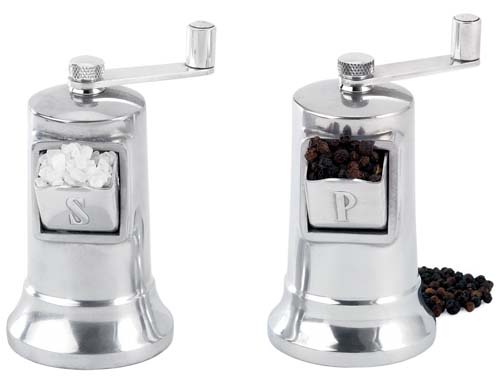 The
reason I wish to emphasize these elements
of mutual enhancement is because far too many
wine tastings take place in
offices, winery labs or homes without any
accompanying food besides a cracker.
(If you’re going to serve a cracker make it a
Saltine.)
The
reason I wish to emphasize these elements
of mutual enhancement is because far too many
wine tastings take place in
offices, winery labs or homes without any
accompanying food besides a cracker.
(If you’re going to serve a cracker make it a
Saltine.)
Such exercises insist on
tasting the wines
purely on their own to detect their virtues
and defects, which is fair enough.
But without fat, salt and pepper, they are
nothing more than exercises, like
testing out a new car by running it in a
garage rather than out on the road,
where one can appreciate its ability to give
pleasure and manifest where there
might be problems.
Were I to hold a
wine tasting, at the very
least there would be some mild cheeses on the
table, along with salt and pepper grinders
whose grains my guests can put on their
tongues. It makes a world of difference, not
least because drinking wine without food is
like learning the tango and never
going out to dance with someone.
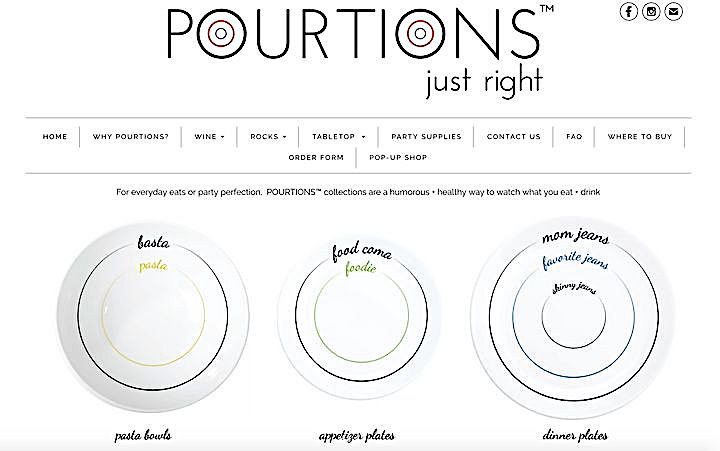 OH, JUST SHUT UP!
OH, JUST SHUT UP!
Macy's removed a line of dishware from sale after
protests that its humorous portion control artwork
would cause body shaming and would lead to women
acquiring eating disorders.
FOR THE WYOMING VALLEY WEST SCHOOL DISTRICT
The Wyoming Valley West
School District in
Pennsylvania told parents who had lunch debt either
to pay up immediately or their children could go
into foster care.
"Your child has been sent to school every day
without money and without a breakfast and/or lunch,"
the letter read. "If you are taken to Dependency
court, the result may be your child being removed
from your home and placed in foster care." The order
was later rescinded.
Any of John Mariani's books below may be ordered from amazon.com.
 The Hound in Heaven
(21st Century Lion Books) is a novella, and
for anyone who loves dogs, Christmas, romance,
inspiration, even the supernatural, I hope you'll find
this to be a treasured favorite. The story
concerns how, after a New England teacher, his wife and
their two daughters adopt a stray puppy found in their
barn in northern Maine, their lives seem full of promise.
But when tragedy strikes, their wonderful dog Lazarus and
the spirit of Christmas are the only things that may bring
his master back from the edge of despair.
The Hound in Heaven
(21st Century Lion Books) is a novella, and
for anyone who loves dogs, Christmas, romance,
inspiration, even the supernatural, I hope you'll find
this to be a treasured favorite. The story
concerns how, after a New England teacher, his wife and
their two daughters adopt a stray puppy found in their
barn in northern Maine, their lives seem full of promise.
But when tragedy strikes, their wonderful dog Lazarus and
the spirit of Christmas are the only things that may bring
his master back from the edge of despair. WATCH THE VIDEO!
“What a huge surprise turn this story took! I was completely stunned! I truly enjoyed this book and its message.” – Actress Ali MacGraw
“He had me at Page One. The amount of heart, human insight, soul searching, and deft literary strength that John Mariani pours into this airtight novella is vertigo-inducing. Perhaps ‘wow’ would be the best comment.” – James Dalessandro, author of Bohemian Heart and 1906.
“John Mariani’s Hound in Heaven starts with a well-painted portrayal of an American family, along with the requisite dog. A surprise event flips the action of the novel and captures us for a voyage leading to a hopeful and heart-warming message. A page turning, one sitting read, it’s the perfect antidote for the winter and promotion of holiday celebration.” – Ann Pearlman, author of The Christmas Cookie Club and A Gift for my Sister.
“John Mariani’s concise, achingly beautiful novella pulls a literary rabbit out of a hat – a mash-up of the cosmic and the intimate, the tragic and the heart-warming – a Christmas tale for all ages, and all faiths. Read it to your children, read it to yourself… but read it. Early and often. Highly recommended.” – Jay Bonansinga, New York Times bestselling author of Pinkerton’s War, The Sinking of The Eastland, and The Walking Dead: The Road To Woodbury.
“Amazing things happen when you open your heart to an animal. The Hound in Heaven delivers a powerful story of healing that is forged in the spiritual relationship between a man and his best friend. The book brings a message of hope that can enrich our images of family, love, and loss.” – Dr. Barbara Royal, author of The Royal Treatment.
 |
The Encyclopedia of American Food and Drink by John F. Mariani (Bloomsbury USA, $35) Modesty forbids me to praise my own new book, but let me proudly say that it is an extensive revision of the 4th edition that appeared more than a decade ago, before locavores, molecular cuisine, modernist cuisine, the Food Network and so much more, now included. Word origins have been completely updated, as have per capita consumption and production stats. Most important, for the first time since publication in the 1980s, the book includes more than 100 biographies of Americans who have changed the way we cook, eat and drink -- from Fannie Farmer and Julia Child to Robert Mondavi and Thomas Keller. "This book is amazing! It has entries for everything from `abalone' to `zwieback,' plus more than 500 recipes for classic American dishes and drinks."--Devra First, The Boston Globe. "Much needed in any kitchen library."--Bon Appetit. |
"Eating Italian will never be the same after reading John Mariani's entertaining and savory gastronomical history of the cuisine of Italy and how it won over appetites worldwide. . . . This book is such a tasteful narrative that it will literally make you hungry for Italian food and arouse your appetite for gastronomical history."--Don Oldenburg, USA Today. "Italian
restaurants--some good, some glitzy--far
outnumber their French rivals. Many of
these establishments are zestfully described
in How Italian Food Conquered the World, an
entertaining and fact-filled chronicle by
food-and-wine correspondent John F.
Mariani."--Aram Bakshian Jr., Wall Street
Journal.
"Equal parts
history, sociology, gastronomy, and just
plain fun, How Italian Food Conquered the
World tells the captivating and delicious
story of the (let's face it) everybody's
favorite cuisine with clarity, verve and
more than one surprise."--Colman Andrews,
editorial director of The Daily
Meal.com. "A fantastic and fascinating
read, covering everything from the influence
of Venice's spice trade to the impact of
Italian immigrants in America and the
evolution of alta cucina. This book will
serve as a terrific resource to anyone
interested in the real story of Italian
food."--Mary Ann Esposito, host of PBS-TV's
Ciao
Italia. "John Mariani has written the
definitive history of how Italians won their
way into our hearts, minds, and
stomachs. It's a story of pleasure over
pomp and taste over technique."--Danny Meyer,
owner of NYC restaurants Union Square
Cafe, The Modern, and Maialino.
|
 |
 |
 |
 |
 |
 |
 |
 |
 Everett Potter's Travel Report:
Everett Potter's Travel Report: 
 Eating Las Vegas
JOHN CURTAS has been covering the Las Vegas
food and restaurant scene since 1995. He is
the co-author of EATING LAS VEGAS – The 50
Essential Restaurants (as well as
the author of the Eating Las Vegas web site: www.eatinglasvegas.
He can also be seen every Friday morning as
the “resident foodie” for Wake Up With the
Wagners on KSNV TV (NBC) Channel 3 in
Las Vegas.
Eating Las Vegas
JOHN CURTAS has been covering the Las Vegas
food and restaurant scene since 1995. He is
the co-author of EATING LAS VEGAS – The 50
Essential Restaurants (as well as
the author of the Eating Las Vegas web site: www.eatinglasvegas.
He can also be seen every Friday morning as
the “resident foodie” for Wake Up With the
Wagners on KSNV TV (NBC) Channel 3 in
Las Vegas.
MARIANI'S VIRTUAL GOURMET
NEWSLETTER is published weekly. Publisher: John Mariani. Editor: Walter Bagley. Contributing Writers: Christopher Mariani,
Robert Mariani, Misha Mariani, John A. Curtas, Gerry Dawes, Geoff Kalish,
and Brian Freedman. Contributing
Photographer: Galina Dargery. Technical
Advisor: Gerry
McLoughlin.
If you wish to subscribe to this
newsletter, please click here: http://www.johnmariani.com/subscribe/index.html
© copyright John Mariani 2019

